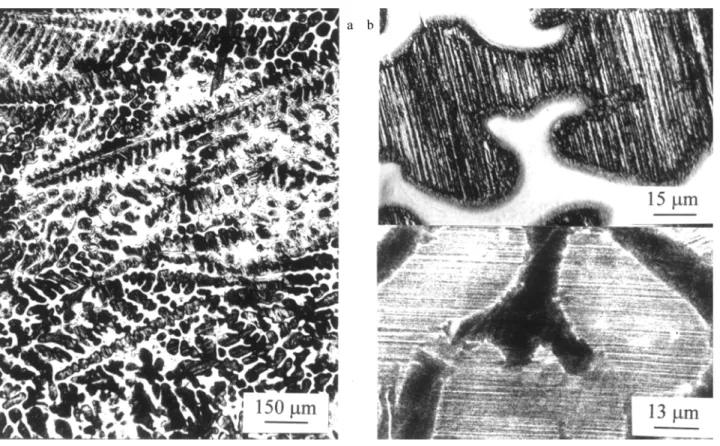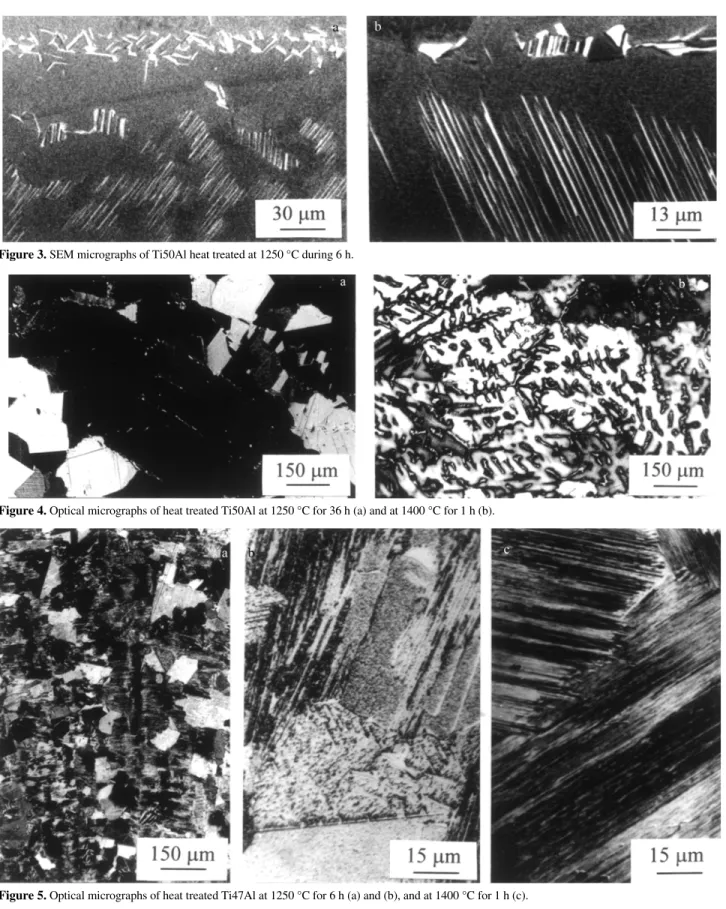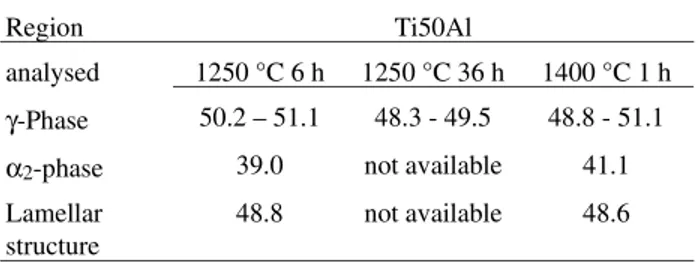As-Cast Titanium Aluminides Microstructure Modification
A. Duarte, F. Viana, Henrique M.C.M. Santos
GMM/IMAT, Departamento de Engenharia Metalúrgica e de Materiais, FEUP Rua dos Bragas, 4099 Porto Codex, Portugal
Received: August 15, 1998; Revised: March 30, 1999
Two cast γ titanium aluminides, Ti47Al and Ti50Al (at. %), were obtained by arc melting under an argon atmosphere. The as-cast microstructure modification by annealing under protective argon atmosphere and hot isostatic pressing (HIP) was analysed by optical and scanning electron micros-copy with microanalysis facilities. As-cast structures presented strong microsegregations, being composed of primary α dendrites (with low Al content), which transformed into lamellar α2 + γ
during solid state cooling, and interdendritic γ phase (with high Al content). Annealing in the α + γ field was responsible for a partial reduction of microsegregation, a decreasing of the volume fraction of α2+γ lamellar dendrites, an increasing of γ volume fraction and the occurrence of a small fraction
of α2 particles and plates in some of the γ grains. Annealing in the α field at 1400 °C for one hour
was insufficient to eliminate the as-cast microstructure in the Ti50Al alloy and produced large equiaxed lamellar colonies of α2+γ in the Ti47Al alloy. HIP in the α + γ field (to avoid excessive
grain growth) was responsible for microstructure modifications similar to the ones obtained by heat treating under similar soaking conditions.
Keywords:titanium aluminides, microstructure, heat treatment
1. Introduction
Titanium aluminides with low density, oxidation resis-tance up to 800 °C and good creep resisresis-tance are promising alloys for high temperature structural applications, the lack of room temperature ductility being the main obstacle to its utilization as engineering materials1,2.
Mechanical properties of these alloys are strongly mi-crostructure dependent. Structures with fine mixtures of γ grains and α2 plates or particles, called “duplex” or
“near-gamma”, conduct to a reasonable balance of properties but at relatively low levels; refined lamellar structures are responsible for properties, up to 760 °C, comparable or better than those of Ni-based superalloys. Several γ-TiAl based alloys with small amounts of refractory elements, for increased high temperature properties, and grain refiners have been studied to attain well-balanced room tempera-ture ductility and high temperatempera-ture strength1.
The solidification of these alloys, accordingly to the phase diagram, occurs through two peritectic reactions, L + β →α and L + α →γ, that will hardly be complete due to limited diffusion caused by the formation of a solid envelope of the peritectic phase, avoiding the physical contact between the reactants. For both peritectic reactions,
high cooling rates or melt undercooling inhibit the forma-tion of the pro-peritectic solid phase; the incompleteness of the peritectic reactions will cause the remaining liquid to progressively enrich in aluminium and solidify, at lower temperatures, as interdendritic γ phase. The as-cast struc-ture presents strong microsegregation and texstruc-ture needing thermomechanical treatments to be eliminated3,4,5. Mi-crosegregation is responsible for aluminium contents vary-ing from 44.7 at. % in α2 + γ dendrites to 48.9 at. % in
interdendritic γ for a Ti48Al2Cr2Nb alloy4, while these figures attain 51 and 56 %, respectively, for a Ti50Al alloy3. During solid state cooling α-dendrites (hcp structure) trans-form into lamellar structures, composed of α + γ phases (this last phase has an ordered fct - L10 structure) and, at
lower temperatures, to α2 + γphases (α2 has an ordered hcp
- DO19 structure)3,6,7.
Homogenizing treatments conducted in the α + γ field are generally inefficient, higher temperatures, in the α field, being usually needed8. Treatments in the α field are respon-sible for excessive grain growth, so the temperature has to be kept low9. Microstructures obtained after cooling from the α phase field are sensitive to the cooling rate: low cooling rates, typically in the furnace, lead to lamellar
structures with α2 and γ lamellae; higher cooling rates are
responsible for a Widmanstätten structure; α to γ massive transformation results from even higher cooling rates. The γ-massive transformation nucleates at α grain boundaries and progresses to the grain interior; for a high cooling rate and/or coarse grain size the transformation may be incom-plete and the grain interiors are not transformed6,7,10,11. For Ti47.5Al and Ti48Al alloys the non transformed areas present very fine lamellae of α2 and γ; these lamellae are
similar to the ones presented by a brine cooled totally α structure Ti40Al after annealing in the α + γ field7,11,12.
The fine lamellar structures are quite different from the coarser ones resulting from slow cooling rates. These are more stable than the fine ones and when heated to 1000 °C coarsen by fragmentation of some lamellae and thickening at the expenses of others that dissolve and γ grains will form at lamellar colony boundaries. If the temperature is raised to 1200 °C, interlamellar spacing increases and coarse α2 particles and plates are present
at non lamellar γ grains13.
2. Materials and Procedures
In this work two titanium aluminides were produced, Ti50Al and Ti47Al (hereafter all compositions are given in atomic percentage), by the arc melting technique under argon atmosphere in a water cooled copper mould. The raw
materials used were Ti and Al high purity bars. A previous casting procedure was established in order to obtain as-cast materials free from macro-segregation, with some ten grams of weight and 14 mm diameter.
HIP was conducted in argon atmosphere at a tempera-ture of 1250 °C during 4 h, under a pressure of about 180 MPa. Alternatively heat treatments were carried out on as-cast aluminides, under a protective argon flux. The samples were submitted to a set of heat treatment cycles. The pre-heating of 10 min at 800 °C was followed by a 10 °C/min heating rate until the maximum temperatures of 1150, 1250, 1350 and 1400 °C for a maximum stage of 6 h. A longer cycle was tested at 1250 °C during 36 h for the Ti50Al alloy. All the samples were cooled inside the fur-nace, at an average rate of 12 °C/min from the maximum temperature to 900 °C.
The as-cast aluminides chemical compositions of Ti and Al were evaluated using 4 different techniques: energy dispersion spectrometry (EDS), wavelength dispersion spectrometry, inductive coupled plasma, and atomic ab-sorption spectrometry. Similar results were achieved inde-pendently of the technique used; the variation around nominal compositions is ± 0.2 at. %. To measure phase chemical compositions the quantitative EDS analysis with standards of pure Al and Ti (FIROZ corrected) was per-formed in the scanning electron microscope (SEM) Jeol JSM 35 C. The accuracy of measurements is ± 0.5 at. %.
Samples not etched were SEM observed under an atomic number contrast.
The samples for optical microscopy (OM) and SEM observation were prepared following standard metal-lographic techniques proposed by Ref. 14. The OM studies used differential interfferential contrast and Kroll’s solu-tion as the etching reagent.
As-cast and HIPed densities were investigated using the Micromeritics Accupyc 1330 pycnometer with 0.001 measurement precision.
3. Results and Discussion
3.1. As-cast structure characterization
The optical microstructure of the as-cast Ti50Al alloy presents long dark dendrites and a white interdendritic phase - see Fig. 1a. Higher magnifications resolve the lamellar nature of the dendritic areas - see Fig. 1b. SEM observations under atomic number contrast reveal a differ-ent chemical composition for the lamellae, with an average Al content of 46.4 to 48.0% - see Table 1; the interdendritic phase has a higher Al content, from 53.4 to 54.0%. Accord-ingly to the phase diagram15, a Ti50Al alloy should com-plete the solidification with α dendritic structure; the occurrence of the interdendritic phase requires coring dur-ing α formation, with consequent Al enrichment of the liquid, which will finally solidify as γ phase as reported by
Ref. 3. The α dendrites transform into α2+γ lamellae during
solid state cooling and the γ phase remains interdendritic. The phase diagram shows that a decrease in Al content of the alloy implies a progressively higher fraction of α phase after solidification, but even for the Ti47Al alloy the interdendritic γ remains in the as-cast structure, enhancing the intensity of the segregation - see Fig. 2. In the lamellar structure a higher aluminium content (see Table 1) has been evaluated in regions near the interdendritic phase, the darker lamellar areas in Fig. 2b. All these features support the assumed coring hypothesis.
3.2. Heat treatment structure characterization
The characteristic microstructures obtained by heat treating Ti50Al in the α + γ field are shown in the Figs. 3 and 4. In the SEM microstructures shown in Fig. 3 the following constituents are identified: γ-phase (dark re-gions); α2 (thicker white regions); and lamellar structure,
remaining from dendrites. It is clear that the dendritic fraction after 6 h at 1250 °C has decreased, showing that solution of α2 + γ dendrites has progressed; even after an
increased stage of 36 h the α2 phase is still present - see Fig.
4a. The phase diagram states that at this temperature a totally γ structure should be obtained, so equilibrium struc-ture has not been reached. Increasing the temperastruc-ture to 1350 °C for 6 h or 1400 °C for 1 h resulted in a dendritic fraction smaller than the one obtained for the 6 h treatment
Table 1. Chemical composition of the as-cast materials, determined by EDS.
Region analysed Chemical composition (at. %)
Ti50Al Ti47Al
Ti Al Ti Al
Lamellar structure 52.0 - 53.6 46.4 - 48.0 not available not available
Bright lamellar structure not available not available 53.9 - 54.9 45.1 - 46.1
Dark lamellar structure not available not available 50.1 - 51.2 48.8 - 49.9
γ-Phase 46.0 – 46.6 53.4 - 54.0 47.7 52.3
at 1250 °C (see Fig. 4b). Microanalysis measurements reinforce the microstructural observations: γ phase de-creases its Al content and lamellar structure becomes richer (see Table 2), approaching equilibrium.
Figure 5 illustrates the dendritic structure attenuation for Ti47Al, along with the γ phase formation. The micro-structures of samples treated in α + γ field - see Figs. 5a and b - reveal a matrix of γ-phase and lamellar grains, duplex
Figure 3. SEM micrographs of Ti50Al heat treated at 1250 °C during 6 h.
Figure 4. Optical micrographs of heat treated Ti50Al at 1250 °C for 36 h (a) and at 1400 °C for 1 h (b).
likely, and a few number of α2 dispersed particles are also
observed. One α phase field treatment produced a fully-la-mellar structure represented in the Fig. 5 c; dendrites are no longer visible after this treatment which may be supposed as capable of producing an equilibrium state, causing a totally α structure after the isothermal stage. The lamellar colony size after this treatment is very high, in agreement with the literature9,13; the minimum colony size measure-ment was 2 mm.
3.3. Hip structure characterization
HIPed microstructure of Ti50Al can not be distin-guished from the one obtained by heat treatment, for similar soaking conditions, in terms of both phase transformation and chemical composition analysis. The measured rate of densification obtained by the HIP process (0.5%) is in the limit of the resolution of the equipment used and should be carefully considered.
4. Conclusions
From this work the following conclusions are with-drawn:
i) as-cast structures of arc-melted Ti50Al and Ti47Al present strong microsegregation, revealed by the system-atic occurrence of interdendritic γ phase;
ii) the efficiency of the homogenizing treatment ap-plied to the as-cast structure of Ti50Al alloy is low; even after high temperatures and long times (1250 ºC for 36 h and 1400 ºC for 1 h) primary dendrites remain visible; iii) as-cast structure of Ti47Al alloy has been de-stroyed by an α field treatment (1400 °C for 1 h), al-though an ultra coarse fully lamellar structure resulted;
iv) HIP microstructure modifications are close to the ones obtained from similar heat treatment conditions.
Acknowledgments
This work was supported by PRAXIS XXI project with reference 3/3.1/CTAE/1904/95. A grant BIC 3621 from PRAXIS XXI was conceded to A. Duarte to cooperate in this project.
References
1. Kim, Y.-W.; Dimiduk, D.M. Structural Intermetallics 1997, Nathal, M.V. et al., eds., TMS, 531, 1997. 2. Froes, F.H.; Suryanarayana, C.; Eliezer, D. J. Mat.
Sci., n. 27, p. 5113, 1992.
3. Shao, G.; Tsakiropoulos, P.; Miodownik, A.P. Mat. Sci. and Techn., n. 13, p. 797, 1997.
4. Muraleedharan, K.; Rishel, L.L.; De Graef, M.; Cramb, A.W.; Pollock, T.M.; Gray III, G.T. ibid, n. 1, p. 215.
5. Naka, S.; Thomas, M.; Sanchez, C.; Khan, T. ibid, n. 1, p. 313.
6. Kumagai, T.; Abe, E.; Nakamura, M. Metall. and Mat. Trans. A, n. 29A, p. 19, 1998.
7. Veeraraghavan, D.; Ramanath, G.; Wang, P.; Vasudevan, V.K. Solid → Solid Phase Transforma-tions, Jonhson, W.C., et al., eds., TMS, 273 (1994). 8. Se mia ti n, S.L.; C hes nutt , J.C .; Austin, C .;
Seetharaman, V. ibid, n. 1, p. 263.
9. Zhang, W.J.; Francesconi, L.; Evangelista, E. Mat. Letters, n. 27, p. 135, 1996.
10. Ramanujan, R.V. ibid, n. 7, p. 881.
11. Abe, E.; Kumagai, T.; Nakamura, M. ibid, n. 1, p. 167. 12. Nakai, K.; Ono, T.; Ohtsubo, H.; Ohmori, Y. Mat.
Trans., JIM, n. 37, p. 813, 1996.
13. Ramanujan, R.V.; Maziasz, P.J.; Liu, T. Acta Mat., n. 44, p. 2611, 1996.
14. Glatz, W.; Retter, B.; Leonhard, A.; Clemens, H.
Structure, n. 29, p. 3, 1996
15. McCullough, C.; Valencia, J.J.; Levi, C.G.; Me-hrabian, R. Acta Metall., n. 37, p. 1321, 1989.
Table 2. Al content of the heat treated materials, determined by EDS.
Region Ti50Al
analysed 1250 °C 6 h 1250 °C 36 h 1400 °C 1 h
γ-Phase 50.2 – 51.1 48.3 - 49.5 48.8 - 51.1
α2-phase 39.0 not available 41.1
Lamellar structure



